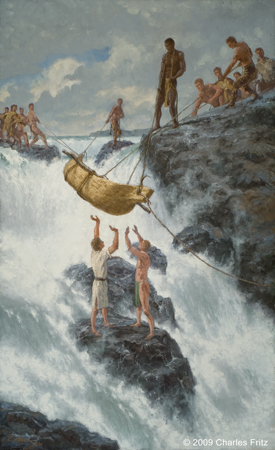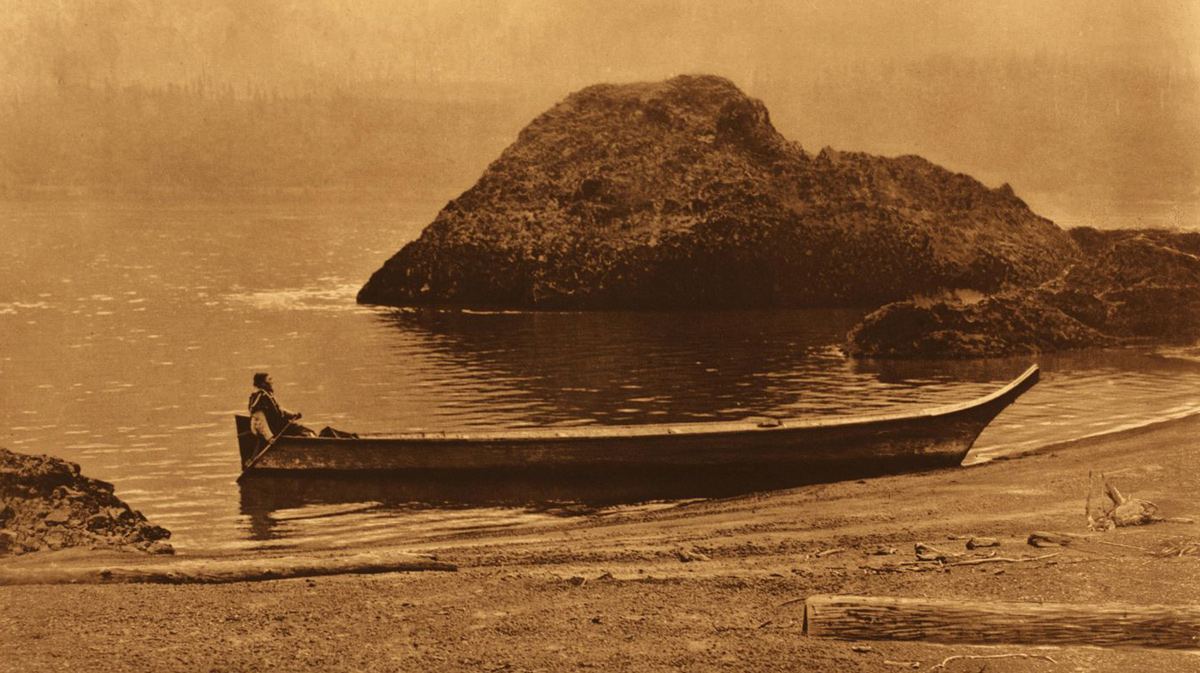The men line the heavy dugout canoes down the Horseshoe Bend of Celilo Falls while Lewis trades their smallest dugout, a hatchet, and a few trinkets for a Chinook-style canoe. Clark shoots at a sea otter—perhaps a harbor seal—and they purchase eight fat dogs for food. Fleas infest everything and at camp, the Wishram leave early—a sign that the rumor of an attack may be true.
Descending the Grand Falls of the Columbia
36″ x 22″ oil on canvas
© 2009 by Charles Fritz. Used by permission.
Lining Horseshoe Bend
at this place [Celilo Falls] we were obliged to let the Canoes down by Strong ropes of Elk Skin which we had for the purpose, one Canoe in passing this place got loose by the Cords breaking, and was cought by the Indians below. I accomplished this necessary business and landed Safe with all the Canoes at our Camp below the falls by 3 oClock P. M.
—William Clark
Thick with Fleas
nearly covered with flees which were So thick amongst the Straw and fish Skins at the upper part of the portage at which place the nativs had been Camped not long Since; that every man of the party was obliged to Strip naked dureing the time of takeing over the canoes, that they might have an oppertunity of brushing the flees of their legs and bodies—
—William Clark
Sea Otters
Great numbers of Sea Otters in the river below the falls, I Shot one in the narrow chanel to day which I could not get.
—William Clark
Unwelcome Threat
Great numbers of Indians visit us both from above and below—. one of the old Chiefs who had accompanied us from the head of the river, informed us that he herd the Indians Say that the nation below intended to kill us, we examined all the arms &c. complete the amunition to 100 rounds. The nativs leave us earlyer this evening than usial, which gives a Shadow of Confirmation to the information of our Old Chief, as we are at all times & places on our guard, are under no greater apprehention than is common.
—William Clark
Eight Fat Dogs
we purchased 8 Small fat dogs for the party to eate the nativs [Wascos and Wishrams] not being fond of Selling their good fish, compells us to make use of Dog meat for food, the flesh of which the most of the party have become fond of from the habits of useing it for Some time past.
—William Clark
Columbia River near Wind River
Edward S. Curtis (1868–1952)
Charles Deering McCormick Library of Special Collections, Northwestern University Libraries.[1]“The Columbia near Wind River”, Edward S. Curtis’s The North American Indian. Accessed 21 January 2023. dc.library.northwestern.edu/items/0148e4f5-659d-412f-a95a-bc5e3005705b.
New Chinook Canoe
I observed on the beach near the Indian Lodges two Canoes butifull of different Shape & Size to what we had Seen above wide in the midde and tapering to each end, on the bow curious figures were Cut on the wood &c. Capt. Lewis went up to the Lodges to See those Canoes and exchanged our Smallest Canoe for one of them by giveing a Hatchet & few trinkets
—William Clark
Weather Diary
Day of the month Wind State of the Weather 23rd S W fair Note from the 22d to the 29th about the Great Falls of the Columbia river.
—William Clark[2]Some abbreviations have been spelled out.
Experience the Lewis and Clark Trail
The Lewis and Clark Trail Experience—our sister site at lewisandclark.travel—connects the world to people and places on the Lewis and Clark Trail.
Plan a trip related to October 23, 1805:

Celilo Falls Portage is a High Potential Historic Site along the Lewis and Clark National Historic Trail managed by the U.S. National Park Service. On-site access is restricted, but nearby Celilo Park provides public viewing and interpretation of the area from the Oregon side of the river.
Notes
| ↑1 | “The Columbia near Wind River”, Edward S. Curtis’s The North American Indian. Accessed 21 January 2023. dc.library.northwestern.edu/items/0148e4f5-659d-412f-a95a-bc5e3005705b. |
|---|---|
| ↑2 | Some abbreviations have been spelled out. |




